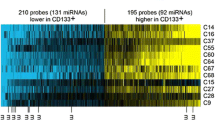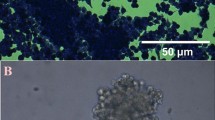Abstract
The cancer stem-like cells (CSLCs) are tumorigenic cells promoting initiation, progression, and spread of the tumor. Accumulating evidences suggested the presence of CSLCs in distinct tumors including laryngeal squamous cell carcinoma (LSCC). MicroRNAs have been proposed as significant regulators of carcinogenesis, and several of them have been demonstrated to have direct roles in survival of CSLCs. In this study, we aimed to explore the role of miR-145, which is downregulated in LSCC, on cancer stem cell potency of laryngeal cancer cells. We initially showed the downregulation of miR-145 expression in tumor tissue samples and in CD133-enriched CSLCs. Quantitative reverse-transcription PCR (qRT-PCR) analysis of miR-145-transfected Hep-2 cells demonstrated the inhibitory role of miR-145 on stem cell markers like SOX2, OCT4, KLF4, and ABCG2. We, then, investigated the stem cell features of miR-145-overexpressing Hep-2 cells by sphere formation assay, single-cell cloning assay, and aldehyde dehydrogenase (ALDH) assay, which all demonstrated the inhibition of stem cell potency upon miR-145 overexpression. Further qRT-PCR analysis demonstrated altered expression of epithelial to mesenchymal transition markers in miR-145-overexpressing Hep-2 cells. In conclusion, we demonstrated the regulatory role of miR-145 in stem cell characteristics of Hep-2 cells. Based on these results, we propose that miR-145 might carry crucial roles in LSCC tumorigenesis, prognosis, metastasis, chemoresistance, and recurrence through regulating stem cell properties of tumor cells.





Similar content being viewed by others
References
Liao WT, Ye YP, Deng YJ, Bian XW, Ding YQ. Metastatic cancer stem cells: from the concept to therapeutics. Am J Stem Cells. 2014;3:46–62.
Dreesen O, Brivanlou AH. Signaling pathways in cancer and embryonic stem cells. Stem Cell Rev. 2007;3:7–17.
Odoux C, Fohrer H, Hoppo T, Guzik L, Stolz DB, Lewis DW, et al. A stochastic model for cancer stem cell origin in metastatic colon cancer. Cancer Res. 2008;68:6932–41.
Fearon ER, Vogelstein B. A genetic model for colorectal tumorigenesis. Cell. 1990;61:759–67.
Hao J, Zhao S, Zhang Y, Zhao Z, Ye R, Wen J, et al. Emerging role of microRNAs in cancer and cancer stem cells. J Cell Biochem. 2014;115:605–10.
Leal JA, Lleonart ME. MicroRNAs and cancer stem cells: therapeutic approaches and future perspectives. Cancer Lett. 2013;338:174–83.
Suer I, Karatas OF, Yuceturk B, Yilmaz M, Guven G, Oz B, et al. Characterization of stem-like cells directly isolated from freshly resected laryngeal squamous cell carcinoma specimens. Curr Stem Cell Res Ther. 2014;9:347–53.
Yu Z, Pestell TG, Lisanti MP, Pestell RG. Cancer stem cells. Int J Biochem Cell Biol. 2012;44:2144–51.
Al-Hajj M, Wicha MS, Benito-Hernandez A, Morrison SJ, Clarke MF. Prospective identification of tumorigenic breast cancer cells. Proc Natl Acad Sci U S A. 2003;100:3983–8.
Singh SK, Clarke ID, Terasaki M, Bonn VE, Hawkins C, Squire J, et al. Identification of a cancer stem cell in human brain tumors. Cancer Res. 2003;63:5821–8.
Ginestier C, Hur MH, Charafe-Jauffret E, Monville F, Dutcher J, Brown M, et al. ALDH1 is a marker of normal and malignant human mammary stem cells and a predictor of poor clinical outcome. Cell Stem Cell. 2007;1:555–67.
Farhadieh RD, Rees CG, Yang JL, Salardini A, Russell P, Smee R. Radiotherapy in larynx squamous cell carcinoma is not associated with an increased diagnosis of second primary tumours. Clin Oncol (R Coll Radiol). 2009;21:315–9.
Yilmaz M, Karatas OF, Yuceturk B, Dag H, Yener M, Ozen M. Alpha-b-crystallin expression in human laryngeal squamous cell carcinoma tissues. Head Neck. 2014.
Martinez NJ, Gregory RI. MicroRNA gene regulatory pathways in the establishment and maintenance of ESC identity. Cell Stem Cell. 2010;7:31–5.
Chen X, Gong J, Zeng H, Chen N, Huang R, Huang Y, et al. MicroRNA145 targets BNIP3 and suppresses prostate cancer progression. Cancer Res. 2010;70:2728–38.
Cao P, Zhou L, Zhang J, Zheng F, Wang H, Ma D, et al. Comprehensive expression profiling of microRNAs in laryngeal squamous cell carcinoma. Head Neck. 2013;35:720–8.
Karatas OF, Yuceturk B, Suer I, Yilmaz M, Cansiz H, Ittmann M, et al. The role of mir-145 in human laryngeal squamous cell carcinoma. Head Neck. 2015.
Livak KJ, Schmittgen TD. Analysis of relative gene expression data using real-time quantitative PCR and the 2(−delta delta c(t)) method. Methods. 2001;25:402–8.
Barrandon Y, Green H. Three clonal types of keratinocyte with different capacities for multiplication. Proc Natl Acad Sci U S A. 1987;84:2302–6.
Pfeiffer MJ, Schalken JA. Stem cell characteristics in prostate cancer cell lines. Eur Urol. 2010;57:246–54.
Pellegrini G, Golisano O, Paterna P, Lambiase A, Bonini S, Rama P, et al. Location and clonal analysis of stem cells and their differentiated progeny in the human ocular surface. J Cell Biol. 1999;145:769–82.
Papini S, Cecchetti D, Campani D, Fitzgerald W, Grivel JC, Chen S, et al. Isolation and clonal analysis of human epidermal keratinocyte stem cells in long-term culture. Stem Cells. 2003;21:481–94.
Li H, Chen X, Calhoun-Davis T, Claypool K, Tang DG. PC3 human prostate carcinoma cell holoclones contain self-renewing tumor-initiating cells. Cancer Res. 2008;68:1820–5.
Zhou ZH, Ping YF, Yu SC, Yi L, Yao XH, Chen JH, et al. A novel approach to the identification and enrichment of cancer stem cells from a cultured human glioma cell line. Cancer Lett. 2009;281:92–9.
Thiery JP, Acloque H, Huang RY, Nieto MA. Epithelial-mesenchymal transitions in development and disease. Cell. 2009;139:871–90.
Iwatsuki M, Mimori K, Yokobori T, Ishi H, Beppu T, Nakamori S, et al. Epithelial-mesenchymal transition in cancer development and its clinical significance. Cancer Sci. 2010;101:293–9.
Mani SA, Guo W, Liao MJ, Eaton EN, Ayyanan A, Zhou AY, et al. The epithelial-mesenchymal transition generates cells with properties of stem cells. Cell. 2008;133:704–15.
Fanali C, Lucchetti D, Farina M, Corbi M, Cufino V, Cittadini A, et al. Cancer stem cells in colorectal cancer from pathogenesis to therapy: controversies and perspectives. World J Gastroenterol. 2014;20:923–42.
Li F, Tiede B, Massagué J, Kang Y. Beyond tumorigenesis: cancer stem cells in metastasis. Cell Res. 2007;17:3–14.
Rane JK, Scaravilli M, Ylipää A, Pellacani D, Mann VM, Simms MS, et al. MicroRNA expression profile of primary prostate cancer stem cells as a source of biomarkers and therapeutic targets. Eur Urol. 2015;67:7–10.
van Rooij E, Purcell AL, Levin AA. Developing microRNA therapeutics. Circ Res. 2012;110:496–507.
Seven M, Karatas OF, Duz MB, Ozen M. The role of miRNAs in cancer: from pathogenesis to therapeutic implications. Future Oncol. 2014;10:1027–48.
Bylund M, Andersson E, Novitch BG, Muhr J. Vertebrate neurogenesis is counteracted by Sox1-3 activity. Nat Neurosci. 2003;6:1162–8.
Xu N, Papagiannakopoulos T, Pan G, Thomson JA, Kosik KS. MicroRNA-145 regulates OCT4, SOX2, and KLF4 and represses pluripotency in human embryonic stem cells. Cell. 2009;137:647–58.
Zhou L, Wei X, Cheng L, Tian J, Jiang JJ. CD133, one of the markers of cancer stem cells in Hep-2 cell line. Laryngoscope. 2007;117:455–60.
Wei XD, Zhou L, Cheng L, Tian J, Jiang JJ, Maccallum J. In vivo investigation of CD133 as a putative marker of cancer stem cells in Hep-2 cell line. Head Neck. 2009;31:94–101.
Yilmaz M, Christofori G. EMT, the cytoskeleton, and cancer cell invasion. Cancer Metastasis Rev. 2009;28:15–33.
Suer I, Karatas OF, Yuceturk B, Yilmaz M, Guven G, Buge O, et al. Characterization of stem-like cells directly isolated from freshly resected laryngeal squamous cell carcinoma specimens. Curr Stem Cell Res Ther. 2014.
Casas E, Kim J, Bendesky A, Ohno-Machado L, Wolfe CJ, Yang J. Snail2 is an essential mediator of Twist1-induced epithelial mesenchymal transition and metastasis. Cancer Res. 2011;71:245–54.
Acknowledgments
We thank Yiqun Zhang for technical assistance in microarray analysis. The studies presented in this manuscript were partially supported by The Scientific and Technological Research Council of Turkey (TUBITAK, grant number 210T009) and by the US National Cancer Institute grant P30CA125123.
Author information
Authors and Affiliations
Corresponding author
Ethics declarations
This study has been reviewed and approved by an institutional review board of Istanbul University, Cerrahpasa Medical School (IRB No. 35697).
Conflicts of interest
None
Informed consent
Patients were included into the study after each of them signed written informed consent forms.
Electronic supplementary material
Below is the link to the electronic supplementary material.
ESM 1
(XLSX 72 kb)
Supplementary Figure 1
(JPEG 44 kb)
Rights and permissions
About this article
Cite this article
Karatas, O.F., Suer, I., Yuceturk, B. et al. The role of miR-145 in stem cell characteristics of human laryngeal squamous cell carcinoma Hep-2 cells. Tumor Biol. 37, 4183–4192 (2016). https://doi.org/10.1007/s13277-015-4219-z
Received:
Accepted:
Published:
Issue Date:
DOI: https://doi.org/10.1007/s13277-015-4219-z




